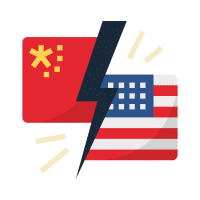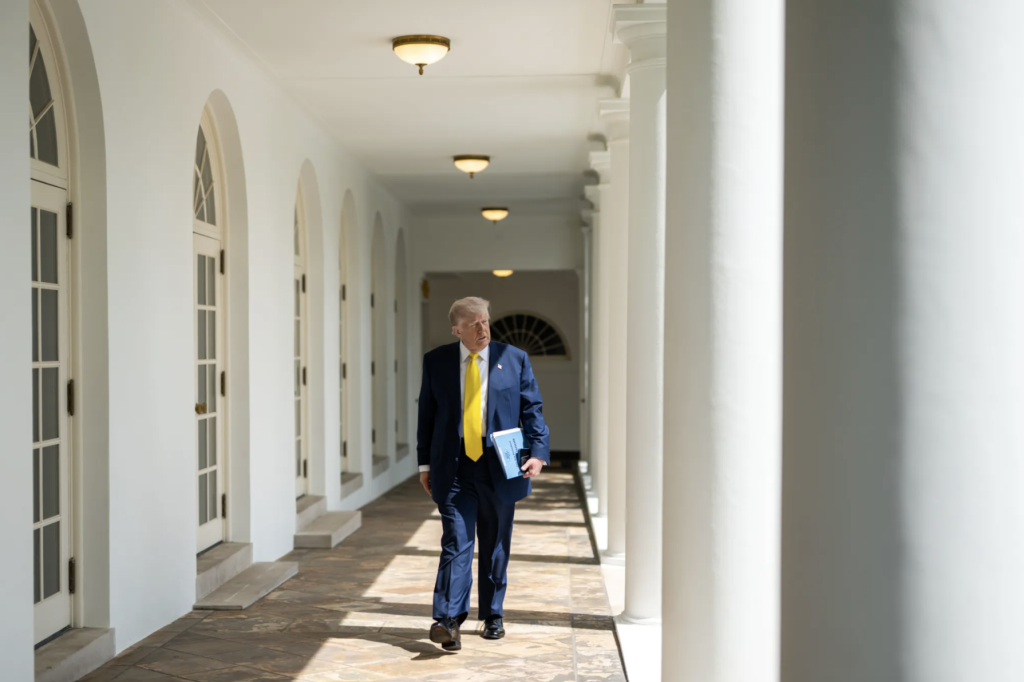Mexico in the Middle: Trump 2.0’s Front Line in the U.S.–China Contest
- Analysis
 China-Focus-Editor
China-Focus-Editor- 08/13/2025
- 0

Source: White House website
[The China Focus at The Carter Center, in cooperation with the China Focus at the University of California, San Diego, and the 1990 Institute, organized an essay contest in honor of President Jimmy Carter. This essay, by Abraham Wu of University of California, San Diego, received The 1990 Institute Prize-Runner Ups. Read more HERE.]
- Storm Warning at the Border
The newest round of U.S.–China competition opens not in the South China Sea but on the tracks at Laredo. A freight train idles there, its wagons stuffed with Mexican wiring harnesses bound for Detroit. Yesterday they crossed at zero duty; today a midnight tweet from President Donald Trump slaps a 25 percent tariff on every part aboard (Mason, Shalal, and Lawder 2025). Traders dump pesos, factories in Monterrey cancel overtime, and Mexico’s brand-new president, Claudia Sheinbaum, discovers that her first crisis is priced in dollars.
The tariff, imposed on 4 March and “suspended” two days later, still chopped almost 10 percent off the peso and shoved Banco de México’s 2025 growth forecast down to 0.6 percent (Esposito and Martinez 2024). It also exposed a deeper fragility: Mexico balances a welfare bill worth 4 percent of GDP on export revenue that the White House can weaponize with a single tweet (Esposito and Martinez 2024).
Meanwhile a different juggernaut is rolling south-to-north. Chinese automakers already hold a fifth of Mexico’s car market (Estefan and Rodríguez Pueblita 2025), and Beijing’s suppliers are pouring billions into plants barely two hours from Texas (FT 2024a). In Mexico City, that looks like salvation; in Washington, like circumvention.
Trump now enters office facing an impossible triangle. He can chase economic independence for MAGA voters, preserve a working partnership with Mexico to police fentanyl and migration, or wage a coherent campaign against China’s foothold—but politics says he cannot maximize all three. How he manages that trilemma over the next 18 months will decide the fate of the USMCA, the peso, and perhaps the balance of power across the Pacific.
The story begins with how the Dragon wooed the Eagle’s closest neighbor.
- The Dragon and the Eagle: How Superpowers Forged Modern Mexico
When China joined the WTO in 2001 its presence in Mexico felt peripheral; two decades on, it is reshaping North America’s division of labor. Between 2014 and 2024, bilateral trade almost doubled—from roughly US $65 billion to US $120 billion— making China Mexico’s second-largest trading partner and its dominant source of imports (FT 2024c). The flow is strikingly one-sided: Mexico sells little more than minerals and farm produce eastward while importing a torrent of machinery, electronics, and finished autos, leaving a 2024 goods-trade gap near US $102 billion (FT 2024c). That imbalance bankrolls a chain of Chinese industrial parks along the Pan-American Highway, letting mainland firms “near-shore” around U.S. tariff walls (Estefan and Rodríguez Pueblita 2025).
Washington keeps reversing course for the past decade. Barack Obama’s High Level Economic Dialogue dangled joint energy and infrastructure projects but delivered only modest sums. Donald Trump replaced carrots with sticks: in 2019 he threatened blanket tariffs unless Mexico stationed troops on its southern border—proof, for many in Mexico City, that the United States would weaponize interdependence. Yet the same president signed the USMCA that year, preserving zero-duty access to a U.S. market that still absorbs about 80 percent of Mexican exports (Trading Economics n.d.). Joe Biden revived tariff pressure on Chinese EVs in 2024 and warned Mexico not to become a trans-shipment hub; U.S. auto lobbies now demand tighter rules of origin in the 2026 USMCA review (Lawder 2024; Brookings Institution 2023).
Beijing, for its part, keeps sweetening the offer. Huawei opened a 5G innovation lab at the Polytechnic University of Querétaro in April 2022 (Mexico-Now 2022). Battery-maker CATL is scouting Chihuahua and Coahuila for a US $5 billion gigafactory (Navarrete 2024). Chinese contractors building a segment of the Tren Maya hint at deeper infrastructure ambitions (Gutiérrez and Navarro 2025). Such projects do more than diversify capital inflows: they reorder Mexico’s domestic bargaining. Northern governors tout Chinese plants as tax bases, steel unions denounce them as job killers, and federal ministries weigh FDI gains against the risk of U.S. retaliation.
In short, China’s rise has turned Mexico into a contested hinge economy. Its internal fault-lines—between states, sectors, and ministries—now figure prominently in the calculations of both Beijing and Washington, setting the stage for the crisis-prone politics explored in the next section.
- Sheinbaum’s Tightrope: Beijing, Washington, Homefront
President Claudia Sheinbaum opens 2025 in a financial pressure cooker: world demand is sagging, every export faces a live-wire tariff threat, and rising real interest rates are choking credit. Inside that squeeze she must keep four plates spinning—and each one hands Donald Trump new leverage.
(1)A divided private sector. Export-oriented manufacturers—from auto wire harness firms in Coahuila to laptop assemblers in Jalisco—see Chinese equity as a lifeline that modernizes tooling yet still slips under USMCA rules. A May 2024 near shoring survey estimates that Chinese firms will make up about 17 percent—roughly sixty-six companies—of the nearly 400 new tenants expected in Mexican industrial parks during 2024-25, with demand clustering in Nuevo León, Coahuila, and Baja California (BBVA Research & AMPIP 2024). Steelmakers and industrial unions, by contrast, loathe Beijing’s advances. At Ternium’s urging the Economy Ministry launched an anti-dumping probe in March 2025 against Chinese and Vietnamese hot rolled coil, warning of 20 000 jobs at risk (Yermolenko 2025).
(2)Brutal fiscal math. Universal pensions, free laptops, and expanded health coverage already cost just over 4 percent of GDP, while the 2024 deficit hit 5.9 percent—the widest since 1987. The 2025 budget trims the gap to a still-hefty 3.9 percent (Esposito and Martinez 2024). Business confederations dread fresh taxes if growth stalls, making Chinese FDI tempting—yet any embrace that angers Washington could trigger a peso rout.
(3)Total dependence on the United States. In 2024 Mexico supplied 15.5 percent of U.S. merchandize imports and bought about US $334 billion in U.S. goods (Mexico News Daily 2025; USTR n.d.). Roughly 80 percent of Mexican exports still head north (Trading Economics n.d.). When Trump floated a 25 percent blanket tariff in late January 2025 the peso dropped 2.3 percent in a single day, and Banxico slashed its 2025 growth forecast by half (Campos 2025). The message: one White House tweet can erase months of macro planning.
(4)A make-or-break USMCA review. Article 34 allows any partner to veto renewal in 2026, raising the specter of full termination in 2036. Brookings analysts warn that failure to renew would freeze battery and semiconductor projects meant to anchor near-shoring (Brookings Institution 2023). To keep the accord alive, Mexico must show it can police Chinese circumvention—likely through U.S.-style forced-labor bans and intrusive data sharing that Morena’s base dislikes.
Every policy move now ricochets among these four vectors. Celebrate a new Chinese EV plant in Nuevo León and steel lobbyists demand harsher dumping duties; float a payroll-tax hike and business confederations insist continued Chinese capital is the cheapest bridge to growth; seek tariff relief at the border and Washington asks for tighter rules of origin. Mexico’s diplomacy is less chess than Jenga: pull the wrong block and the tower of industrialization, welfare, and sovereignty can topple. Worse, the board is asymmetric—Washington holds the bigger pieces. If the tower starts to wobble, access to the U.S. market is the only quick stabilizer, giving Trump an even stronger incentive to squeeze Beijing out of Mexico’s value chains through coercion first and compromise later.
- Trump’s Trilemma: Domestic Politics as Double-Edged Sword
Mexico’s swaying industrial tower offers Washington leverage: every peso wobble or rules-of-origin tweak can be cashed in as pressure on Beijing. Yet every move that sharpens U.S. bargaining power abroad ricochets back into domestic politics at home. Tariffs that punish Chinese circumvention lift retail prices within weeks; rumblings about terminating the USMCA spook Midwestern farmers and Texas refiners who live off north–south corridors. The Trump inner circle therefore frames policy through a three-sided calculus rooted in U.S. electoral incentives (FT 2024b; Americas Quarterly 2025; Reuters 2025b):
(1)Economic independence to satisfy the MAGA base—reshore jobs, narrow trade gaps, and punish offshoring.
(2)Partnership with Mexico to curb fentanyl, migration surges, and supply-chain shocks that could hurt swing-state consumers.
(3)A coherent counter-China strategy to placate national-security hawks and GOP donors who view Beijing’s technological foothold as an existential threat demanding a grand strategic response.
Because each goal is championed by a different U.S. constituency—Rust-Belt unions, border-state pragmatists, and China hawks—no configuration satisfies all three. The administration is locked in a choose-two game:
Option A unleashes broad tariffs, snap-back clauses, and a new USMCA chapter banning firms with ≥25 percent Chinese ownership from preferential rules of origin. Rust-Belt voters rejoice, but near-shoring unravels, U.S. consumers pay the tax, and Beijing doubles down in Brazil and Argentina.
Dyad Domestic Upside Inevitable Casualty
- Independence + Counter-China
- Independence + Partnership
- Partnership + Counter-China
Rust-Belt applause; State and Senate hawks cheer snap-backs
Tariffs wielded as bargaining chips; headline wins on the border
Strategists’ dream: a North American tech bloc
Breaks cooperation on migration and jacks up consumer prices
China merely reroutes via loopholes; nationalist media decry “softness”
Politically remote option. MAGA autarky rebels; House deficit hawks reject subsidies; unions fear job leakage.
Option B turns tariffs into bargaining chips. March 2025 previewed the script: Mexico deployed 10 000 National Guard troops, and Washington suspended tariffs for a month (Reuters 2025a). The U.S. might sweeten future deals with Development Finance Corporation loans for chip back-end plants if they exclude Chinese gear. But the approach is transactional. Move the goalposts—such as tying tariff relief to steel quotas—and trust evaporates; Chinese capital simply pivots from autos to white goods.
Option C—Rubio’s Senate-era “lodestar,” now championed (but politically remote) in his role as Secretary of State—would forge a genuine North American tech alliance: joint 5G build-outs, co-produced EV batteries, harmonized forced-labor bans, and a united front against BRI debt traps. Delivering it, however, would require subsidizing Mexican lithium refineries, guaranteeing tariff predictability, and tolerating some Huawei antennas—moves that clash with MAGA autarky rhetoric, House deficit hawks, and steel-union demands.
Early signals show Trump oscillating between A and B. A steel-dumping probe pleases China hawks; a temporary waiver tests Mexico’s obedience. But a sustained A invites inflation and farm-belt backlash, while a long-running B looks tepid to conservative media. Unless the White House finds money for on-shoring and shields voters from higher prices, the trilemma will remain unresolved—setting the stage for policy whiplash as the 2026 USMCA review approaches.
- Confronting the Dragon in the South: Why the U.S. Push Will Flicker, Not Endure
Unable to stabilize the triangle, the administration drifts into a hybrid “coercion plus-transaction” groove—snap-back auto tariffs, forced-labor audits, USMCA dispute panels, then quick waivers, DFC sweeteners, or guest-worker quotas when Mexico tightens the border. Politically, the cycle lets Trump claim he is tough on China without inflicting a blanket price shock on U.S. shoppers. Strategically, it bruises headline projects—Huawei towers, splashy EV plants—but never long enough to reroute global supply chains away from Mexico.
Chinese firms adapt. Ownership detours through Singaporean holding companies; upstream modules appear as “third-party content” under looser origin rules; new money shifts from autos to refrigerators. Each U.S. clampdown whacks one mole only to watch another pop up. Mexico, conscripted into perpetual crisis management, will tighten rules of origin and fentanyl interdiction during market panics, then quietly court CATL or LONGi once the peso stabilizes. Volatility encourages short-term fixes—tax holidays, fast-track permits—over the multi-year industrial strategy that genuine decoupling would demand.
Coercion without sustained, rules-based inducements thus breeds circumvention. Episodic tariffs lack the predictability investors need to rebuild capacity elsewhere. By opting for headline victories over institutional permanence, Trump 2.0 keeps Mexico a contested hinge economy—and ensures that Washington’s attempt to crowd out Beijing in North America will flare brightly, then flicker. Absent a durable, rules-based strategy that pairs selective coercion with deep investment incentives, Washington will keep whacking tariff moles while Beijing quietly builds new factories—and the center of gravity in North America will tilt ever further toward China.
(The notes in the text are available upon request from the editor.)



